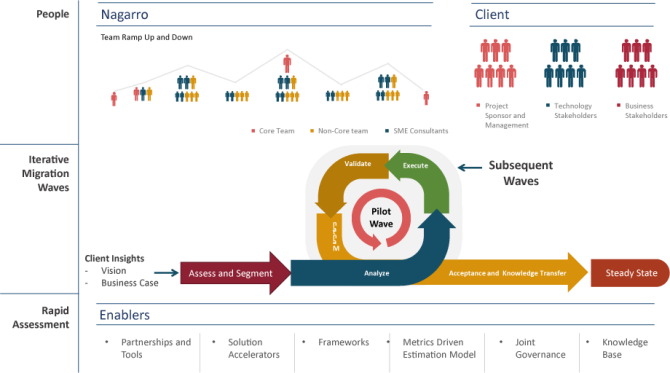The Nagarro Factory Model
Nagarro’s Center of Excellence (COE) developed the Factory Model so large enterprises can manage technology modernization initiatives more effectively and in an optimized manner over time. The Factory Model defines centralized services and processes that are specific to technology modernization. It allows organizations to achieve economies of scale by leveraging a centralized infrastructure, a metrics-based estimation model, and well-defined collaboration between the multiple groups involved in a modernization initiative.
The Factory Model combines a methodology, tools, accelerators and partnerships between Nagarro and industry-leading vendors to speed execution and to increase the predictability and reliability of outcomes. The foundational elements of the Factory Model are:
- Assessment
- Factory Setup
- Execution Waves
- On-Demand Talent Planning
The Factory Model’s lifecycle approach is ideally suited to large modernization initiatives that involve several stages. It enables rapid iteration, allowing enterprises to execute massive modernization efforts without major disruptions and cost leakages.
Assessment
In this initial phase, applications are assessed for complexity based on customizations and integration points, business value, and alignment with current and future business needs and then prioritized in a business plan for the modernization roll-out. In most situations, a complex application catalog is transformed into an agile portfolio that aligns with the client’s business requirements.
To speed and ensure the accuracy of assessments, Nagarro uses various Rapid Assessment tools and pre-defined templates, checklists, questionnaires and models that capture requirements. The resulting data is analyzed and presented in easy-to-understand dashboards or other visual tools so the scope of the modernization effort is clear and projects can be prioritized.
Factory Setup
Factory setup ensures that the required infrastructure and processes are in place to streamline modernization execution. It allows organizations to enforce best practices, minimize organizational constraints, and more effectively leverage the knowledge they gain and the assets they produce over time.
During this phase, the responsibilities of individual stakeholders are defined and communications SLAs are established. The Nagarro team ensures that the Factory Model setup aligns with the client’s business goals and that it is optimized for operational efficiency and continuous improvement.
Just prior to the execution phase, applications with varying complexity are clustered into waves. Each wave is then executed according to the modernization strategy.
Execution Waves
The Pilot Wave is the first stage of the implementation phase. Its purpose is to solidify the execution strategy, demonstrate the effectiveness of the Factory Model to stakeholders, and show stakeholders how the new features satisfy specific business requirements.
During the Pilot Wave, partners, tools, frameworks and reusable components are selected. Subsequently, the infrastructure including development and testing environments are set up. In addition, project governance and operational processes are established and tested.
Since modernization initiative related challenges and issues vary depending on the technological complexity of existing applications, the Factory Model records such obstacles and the effectiveness of their resolutions during every wave of execution. The resulting knowledge base helps optimize the execution of later-stage waves. It also simplifies subsequent modernization initiatives which reduces overall effort and improves ROI.

Depending on the client’s needs, waves subsequent to the Pilot Wave may be executed in parallel to improve efficiency. Every wave is executed based on a phased approach that includes analysis and design, execution, validation, and management.
On-Demand Talent Planning
Successful modernization efforts necessarily involve the business and technical stakeholders who will impact the initiative at some point in time. Because internal resources are usually limited, clients rely on Nagarro to supplement internal skill sets and accelerate delivery cycles.
Since every modernization wave has its own requirements, people are allocated accordingly. During ramp-up, execution, and ramp-down, the mix of business domain, process, and technical experts adjusts based on the needs of the project wave although a core team remains engaged throughout the engagement to ensure continuity, success, and the ongoing optimization of processes and technical solutions. As projects move toward closure and their resource requirements decrease, any surplus resources are reassigned to other projects as required. This elasticity ensures that clients have access to the expertise they need when they need it.
Key Benefits of Factory Model Execution
- Flexibility – the model and resources can be adapted to suit the client’s unique requirements throughout the lifecycle.
- Predictability– the methodology, processes, tools, and knowledge base ensure project quality, system reliability, and more predictable outcomes.
- Risk mitigation –accurate views of the environment, project scope, and resources required enable more effective cost control and faster time to market. Technical, operational, and business risks can be identified and managed more efficiently, earlier in the lifecycle.
- High visibility – stakeholders have accurate data about the environment, project scope, wave priorities, required resources, team member responsibilities, issues, and outcomes.
- Governance – ensures the appropriate use of people, systems, business structures, and practices.
Fortune 500 companies and other industry leaders are taking advantage of the Nagarro Factory Model to accelerate and improve the outcomes of their modernization initiatives. With Nagarro’s assistance, organizations can deliver more reliable business solutions on time, on budget, with fewer execution errors, and without disruptions.


